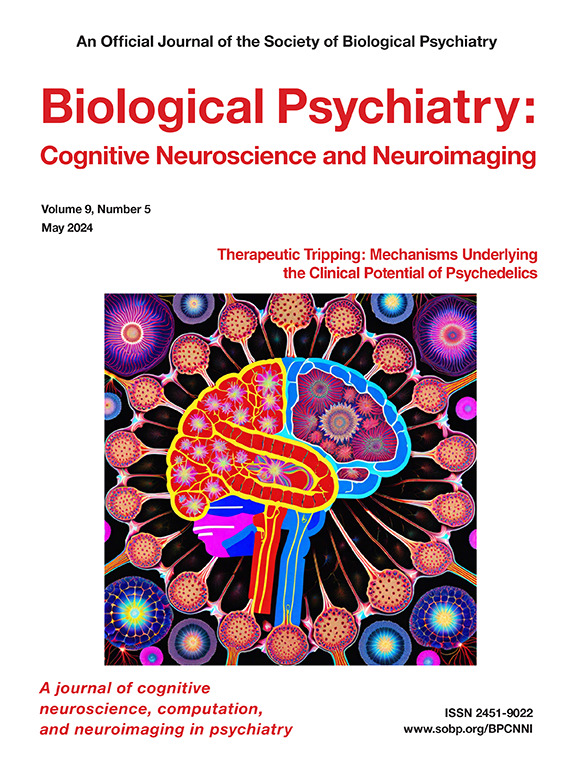Dose-Dependent Target Engagement of a Clinical Intermittent Theta Burst Stimulation Protocol: An Interleaved Transcranial Magnetic Stimulation–Functional Magnetic Resonance Imaging Study in Healthy People
IF 4.8
2区 医学
Q1 NEUROSCIENCES
Biological Psychiatry-Cognitive Neuroscience and Neuroimaging
Pub Date : 2025-08-01
DOI:10.1016/j.bpsc.2024.08.009
引用次数: 0
Abstract
Background
Intermittent theta burst stimulation (iTBS) of the dorsolateral prefrontal cortex (DLPFC) is widely applied as a therapeutic intervention in mental health; however, the understanding of its mechanisms is still incomplete. Prior magnetic resonance imaging (MRI) studies have mainly used offline iTBS or short sequences in concurrent transcranial magnetic stimulation (TMS)–functional MRI (fMRI). This study investigated a full 600-stimuli iTBS protocol using interleaved TMS-fMRI in comparison with 2 control conditions in healthy subjects.
Methods
In a crossover design, 18 participants underwent 3 sessions of interleaved iTBS-fMRI: 1) the left DLPFC at 40% resting motor threshold (rMT) intensity, 2) the left DLPFC at 80% rMT intensity, and 3) the left primary motor cortex (M1) at 80% rMT intensity. We compared immediate blood oxygen level–dependent (BOLD) responses during interleaved iTBS-fMRI across these conditions including correlations between individual fMRI BOLD activation and iTBS-induced electric field strength at the target sites.
Results
Whole-brain analysis showed increased activation in several regions following iTBS. Specifically, the left DLPFC, as well as the bilateral M1, anterior cingulate cortex, and insula, showed increased activation during 80% rMT left DLPFC stimulation. Increased BOLD activity in the left DLPFC was observed with neither 40% rMT left DLPFC stimulation nor left M1 80% rMT iTBS, whereas activation in other regions was found to overlap between conditions. Of note, BOLD activation and electric field intensities were only correlated for M1 stimulation and not for the DLPFC conditions.
Conclusions
This interleaved TMS-fMRI study showed dosage- and target-specific BOLD activation during a 600-stimuli iTBS protocol in healthy individuals. Future studies may use our approach for investigating target engagement in clinical samples.
临床 iTBS 方案的剂量依赖性目标参与:健康受试者的交错 TMS-fMRI 研究。
背景:对背外侧前额叶皮层(DLPFC)的间歇θ脉冲刺激(iTBS)被广泛应用于心理健康的治疗干预,但对其机制的了解仍不全面。之前的磁共振成像研究主要使用离线 iTBS 或同期 TMS-fMRI 的短序列。本研究使用交错 TMS-fMRI 对 600 个刺激的 iTBS 方案进行了研究,并与健康受试者的两种对照条件进行了比较:在交叉设计中,18 名参与者接受了三次交错 iTBS-fMRI 治疗:1)静息运动阈值 (rMT) 强度为 40% 的左侧 DLPFC;2)静息运动阈值 (rMT) 强度为 80% 的左侧 DLPFC;3)静息运动阈值 (rMT) 强度为 80% 的左侧初级运动皮层 (M1)。我们比较了这些条件下交错 iTBS-fMRI 期间的即时血氧水平依赖性(BOLD)反应,包括目标部位的单个 fMRI BOLD 激活与 iTBS 诱导的电场(E-field)强度之间的相关性:结果:全脑分析显示,iTBS 后多个区域的激活增加。具体而言,左侧DLPFC以及双侧M1、前扣带回皮层和岛叶在80% rMT刺激左侧DLPFC时显示出激活增加。在对左侧DLPFC进行40% rMT刺激或对左侧M1进行80% rMT iTBS刺激时,均未观察到左侧DLPFC的BOLD活动增加,而其他区域的激活在不同条件下有重叠。值得注意的是,BOLD 激活和 E 场强度只与 M1 刺激相关,而与 DLPFC 条件无关:该研究显示,在健康受试者中使用 600 个刺激 iTBS 进行交错 TMS-fMRI 时,会出现剂量和目标特异性 BOLD 激活。未来的研究可能会使用我们的方法来证明目标参与。
本文章由计算机程序翻译,如有差异,请以英文原文为准。
求助全文
约1分钟内获得全文
求助全文
来源期刊

Biological Psychiatry-Cognitive Neuroscience and Neuroimaging
Neuroscience-Biological Psychiatry
CiteScore
10.40
自引率
1.70%
发文量
247
审稿时长
30 days
期刊介绍:
Biological Psychiatry: Cognitive Neuroscience and Neuroimaging is an official journal of the Society for Biological Psychiatry, whose purpose is to promote excellence in scientific research and education in fields that investigate the nature, causes, mechanisms, and treatments of disorders of thought, emotion, or behavior. In accord with this mission, this peer-reviewed, rapid-publication, international journal focuses on studies using the tools and constructs of cognitive neuroscience, including the full range of non-invasive neuroimaging and human extra- and intracranial physiological recording methodologies. It publishes both basic and clinical studies, including those that incorporate genetic data, pharmacological challenges, and computational modeling approaches. The journal publishes novel results of original research which represent an important new lead or significant impact on the field. Reviews and commentaries that focus on topics of current research and interest are also encouraged.
 求助内容:
求助内容: 应助结果提醒方式:
应助结果提醒方式:


